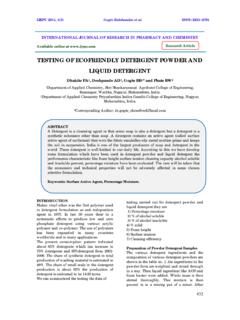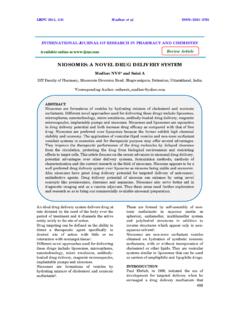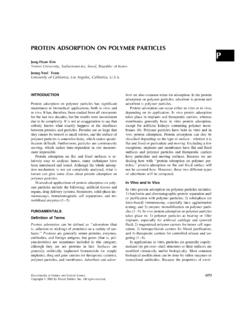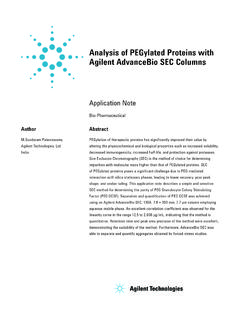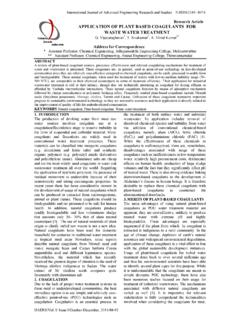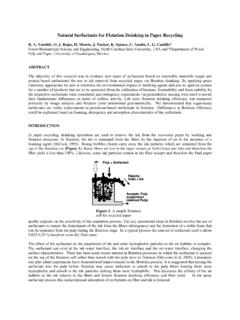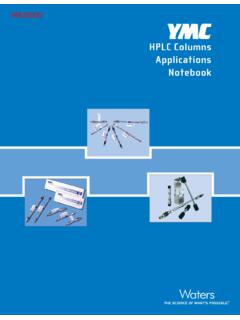Transcription of MICROSPHERE: A REVIEW - IJRPC
1 IJRPC 2011, 1(4) Sahil Kataria et al. ISSN: 2231 2781. INTERNATIONAL JOURNAL OF RESEARCH IN PHARMACY AND CHEMISTRY. Available online at REVIEW Article MICROSPHERE: A REVIEW . Kataria Sahil1, Middha Akanksha1, Sandhu Premjeet1, Ajay Bilandi and Bhawana Kapoor 1 Seth G. L. Bihani College of Technical Education, Institute of Pharmaceutical Sciences and Drug Research, Sri Ganganagar, Rajasthan, India. *Corresponding Author: ABSTRACT. microspheres are characteristically free flowing powders consisting of proteins or synthetic polymers having a particle size ranging from 1-1000 m. The range of Techniques for the preparation of microspheres offers a Variety of opportunities to control aspects of drug administration and enhance the therapeutic efficacy of a given drug. There are various approaches in delivering a therapeutic substance to the target site in a sustained controlled release fashion. One such approach is using microspheres as carriers for drugs also known as microparticles.
2 It is the reliable means to deliver the drug to the target site with specificity, if modified, and to maintain the desired concentration at the site of interest. microspheres received much attention not only for prolonged release, but also for targeting of anticancer drugs. In future by combining various other strategies, microspheres will find the central place in novel drug delivery, particularly in diseased cell sorting, diagnostics, gene & genetic materials, safe, targeted and effective in vivo delivery and supplements as miniature versions of diseased organ and tissues in the body. Keywords: microspheres , controlled release, therapeutic efficacy, novel drug delivery. INTRODUCTION microspheres . microspheres are small spherical particles, Polystyrene microspheres are typically used in with diameters in the micrometer range biomedical applications due to their ability to (typically 1 m to 1000 m). microspheres are facilitate procedures such as cell sorting and sometimes referred to as microparticles.
3 Immuno precipitation. Proteins and ligands microspheres can be manufactured from adsorb onto polystyrene readily and various natural and synthetic materials. Glass permanently, which makes polystyrene microspheres , polymer microspheres and microspheres suitable for medical research ceramic microspheres are commercially and biological laboratory experiments. available. Solid and hollow microspheres vary Polyethylene microspheres are commonly widely in density and, therefore, are used for used as permanent or temporary filler. Lower different applications. Hollow microspheres melting temperature enables polyethylene are typically used as additives to lower the microspheres to create porous structures in density of a material. Solid microspheres have ceramics and other materials. High sphericity numerous applications depending on what of polyethylene microspheres , as well as material they are constructed of and what size availability of colored and fluorescent they are.
4 microspheres , makes them highly desirable for Polyethylene and polystyrene microspheres flow visualization and fluid flow analysis, are two most common types of polymer microscopy techniques, health sciences, 1184. IJRPC 2011, 1(4) Sahil Kataria et al. ISSN: 2231 2781. process troubleshooting and numerous systems have been developed as they releases research applications. Charged polyethylene the drug slowly into the GIT and maintain a microspheres are also used in electronic paper constant drug concentration in the serum for digital displays. longer period of time. However, incomplete Glass microspheres are primarily used as filler release of the drug and a shorter residence for weight reduction, retro-reflector for time of dosage forms in the upper highway safety, additive for cosmetics and gastrointestinal tract, a prominent site for adhesives, with limited applications in absorption of many drugs, will lead to lower medical technology.
5 Bioavailability. Efforts to improve oral drug Ceramic microspheres are used primarily as bioavailability have grown in parallel with the grinding media. pharmaceutical industry. As the number and microspheres vary widely in quality, chemical diversity of drugs has increased, new sphericity, uniformity of particle and particle strategies are required to develop orally active size distribution. The appropriate microsphere therapeutics. Thus, gastro retentive dosage needs to be chosen for each unique forms, which prolong the residence time of the application5 drugs in the stomach and improve their The range of techniques for the preparation of bioavailability, have been developed2. microspheres offers a variety of opportunities A well designed controlled drug delivery to control aspects of drug administration. This system can overcome some of the problems of approach facilitates the accurate delivery of conventional therapy and enhance the small quantity of the potent drugs, reduced therapeutic efficacy of a given drug.
6 To obtain drug concentration at the site other than the maximum therapeutic efficacy, it becomes target site and the protection of the labile necessary to deliver the agent to the target compound before and after the administration tissue in the optimal amount in the right and prior to appearance at the site of action. period of time there by causing little toxicity The behavior of the drugs in vivo can be and minimal side effects. There are various manipulated by coupling the drug to a carrier approaches in delivering a therapeutic particle. The clearance kinetics, tissue substance to the target site in a sustained distribution, metabolism and cellular controlled release fashion. One such approach interaction of the drug are strongly influenced is using microspheres as carriers for drugs. by the behavior of the carrier. The exploitation microspheres are characteristically free of these changes in pharmacodynamics flowing powders consisting of proteins or behavior may lead to enhanced therapeutic synthetic polymers which are biodegradable effect.
7 However, an intelligent approach to in nature and ideally having a particle size less therapeutics employing drug carrier's than 200 m3. technology requires a detailed understanding of the carrier interaction drugs in vivo can be CHARACTERISTICS. manipulated by coupling the drug to a carrier particle. The clearance kinetics, tissue Table 1: Microsphere property9. distribution, metabolism and cellular S. No. Property Consideration 1 Size Diameter interaction of the drug are strongly influenced Uniformity/distribution by the behavior of the carrier. The exploitation 2 Composition Density of these changes in pharmacodynamics Refractive index behavior may lead to enhanced therapeutic Hydrophobicity/hydrophilicity Nonspecific binding effect. The goal of any drug delivery system is Autofluorescence to provide a therapeutic amount of drug to the 3 Surface Reactive groups proper site in the body to achieve promptly chemistry Level of functionalization and then maintain the desired drug Charge 4 Special Visible dye/fluorophore concentration properties Super-paramagnetic The most convenient and commonly employed route of drug delivery has historically been by oral ingestion 1.
8 Microsphere size may be critical to the Drugs that are easily absorbed from the GIT proper function of an assay, or it may be and having a short half-life are eliminated secondary to other characteristics. quickly from the blood circulation. To avoid Considering traditional diagnostic methods, these problems oral controlled drug delivery the test or assay format commonly dictates 1185. IJRPC 2011, 1(4) Sahil Kataria et al. ISSN: 2231 2781. particle size, such as the use of very small adjusted to produce beads with different spheres (~ m) to ensure satisfactory intensities to meet special needs, such as wicking in lateral flow tests, or the use of QuantumPlex for multiplexed flow larger, cell-sized spheres (~4-10 m) for bead- cytometric assays, or our Dragon Green or based flow cytometric assays. Flash Red Intensity Standards, which support 2. Common microsphere compositions imaging applications and associated include polystyrene (PS), poly(methyl instrument QC.)
9 Many surface- or internally- methacrylate) (PMMA), and silica. These labeled fluorescent beads are also available as materials possess different physical and specialized flow cytometry optical properties, which may present advantages or limitations for different ADVANTAGES. applications. Polymer beads are generally 1. microspheres provide constant and hydrophobic, and as such, have high protein prolonged therapeutic effect. binding abilities. However, they often require 2. Reduces the dosing frequency and thereby the use of some surfactant ( improve the patient compliance. Tween 20 or SDS) in the storage buffer to 3. They could be injected into the body due to ensure ease of handling. During synthesis, the spherical shape and smaller size. functional monomers may be co-polymerized 4. Better drug utilization will improve the with styrene or methyl methacrylate to bioavailability and reduce the incidence or develop beads with surface reactive groups.
10 Intensity of adverse effects. Functional groups may be used in covalent 5. Microsphere morphology allows a binding reactions, and also aid in stabilizing controllable variability in degradation and the suspension. Silica microspheres are drug inherently hydrophilic and negatively charged. Consequently, aqueous silica LIMITATION. suspensions rarely require use of surfactants Some of the disadvantages were found to be as or other stabilizers. Carboxyl- and amine follows functionalized silica spheres are available for 1. The modified release from the formulations. use in common covalent coating protocols, 2. The release rate of the controlled release and plain silica microspheres may be dosage form may vary from a variety of modified using a variety of silanes to generate factors like food and the rate of transit though functional groups or alter surface properties. gut. 3. microspheres may be coated with 3. Differences in the release rate from one dose capture molecules, such as antibodies, to another.
